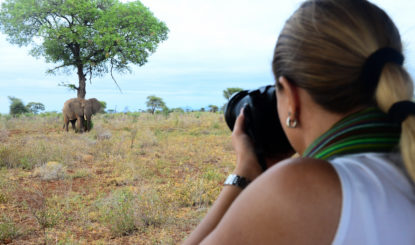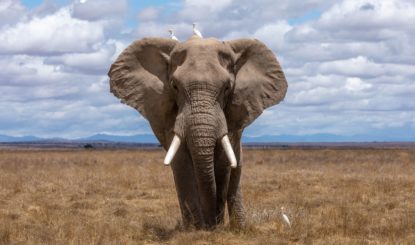Fondation Franz Weber saves a small herd of elephants in South Africa
In South Africa, unlike other African countries, virtually all elephant populations in the country live in fenced reserves and parks. This form of elephant management is as inadequate and disastrous for the species as it is for the ecosystem – and creates a host of problems as the confined animals breed and their numbers increase.
Recently, Fondation Franz Weber facilitated the relocation of elephants declared as “surplus” from a too-small reserve in north-west South Africa to a larger park, thus preventing their killing.
South Africa is unique in Africa when it comes to elephants. The country’s immediate neighbours – Botswana, Namibia, Mozambique and Zimbabwe – are renowned for their great herds of free-roaming elephants. South Africa’s elephants, on the other hand, are almost entirely fenced in. Even the famous Kruger National Park, home to around 20,000 elephants, is almost entirely surrounded by a fence. The rest of South Africa’s elephant populations are splintered into a patch-work of hundreds of fragmented game parks and reserves, many of which are too small to house even a modest size family herd of elephants.
Elephants need a lot of space to roam, they are migratory by nature and are naturally used to travelling great distances in search of food and water. Having them cooped up in fenced reserves that are too small for their needs, causes stress to the elephants, damage to the natural habitat and overall health of the ecosystem, especially if those herds begin to breed and expand in number.
South Africa’s species management needs to be reviewed
Therefore, South Africa is forced to manage its elephant populations. The government has developed a National Norms and Standards for the Management of Elephants which recognises the problems associated with small reserves and elephants and has therefore provided guidelines on how to manage them. If a reserve is deemed to have too many elephants for a particular space, options to manage them include: the translocation of elephants to bigger reserves, providing natural contraception to breeding females to minimise population growth, trophy hunting and, as a last resort, culling.
Unfortunately, for many reserves trophy hunting and culling are the only options as the cost and the logistics of translocation is massive, while contraception only mitigates the problem if done before a population becomes too big, which in many cases is too late.
Trophy hunting: disproportionate and inefficient
Of course, trophy hunting and culling as last resorts are seriously problematic for obvious ethical reasons. Also, neither seem to be very effective as management tools: Trophy hunting because, by law, only old bulls are allowed to be killed, which often leaves a reserve with a surplus of female elephants, and old bulls are vital to balance herd dynamics especially among younger males. While culling, because of the high level of sentience and sapience among elephants, requires the killing of entire family groups, including babies, as any left alive will be severely traumatised for life.
A small reserve is bursting
In the north-west of the country is one such reserve facing the dilemma of having too many elephants. Due to its small size, the park has been struggling with an overpopulation of elephants for a number of years. The park has been under pressure to have their excess elephants removed, but they are unable to afford the costs and carry out the complicated undertaking to translocate the herd, while contraception would work only after some of the excess elephants have been removed.
Why are contraceptives used for South Africa’s elephants?
Due to the problem of fragmented fenced populations in small reserves, contraception has become a necessary and cost-effective tool in the management of elephants in South Africa. Elephant immunocontraception uses the female elephant’s own immune response to block egg fertilisation. Female elephants over the age of 10 years are darted remotely from a helicopter with a dropout dart that contains the immunocontraception vaccine and a marking dye. This marks the elephant at the dart site, creating a quick aerial reference of which animals have been darted. The dart falls out a short while afterwards. Thus, the animals do not need to be immobilised in order to be treated and the vaccinations are completed within minutes.
Translocation instead of killing with the help of Fondation Franz Weber
With the reserve potentially looking at the last resort, Fondation Franz Weber, in partnership with Human Society International, the Elephant Reintegration Trust and Global Supplies-Conservation Initiatives, decided to step in to translocate a family of six elephants to a much bigger park elsewhere in the country.
“Culling a family of elephants because the game park is too small for them must never be an option, even as a last resort, especially since African elephant populations are threatened throughout the continent,” says Vera Weber, President Fondation Franz Weber. “That is why we did not hesitate to facilitate the best alternative – translocate them to a much bigger park where they can roam free without fear of being killed for space.”
A huge logistical task
The process, however, is a complex and intricate undertaking that requires teams of veterinary experts, elephant biologists, rangers, elephant transportation specialists as well as dozens of handlers. A helicopter is required to dart the elephants first before the teams on the ground move in. They take DNA and blood samples from the animals, measure them and give them a health check. A bulldozer is used to quickly clear a path through the bush so that trucks and a crane can arrive to lift the animals. While still completely sedated, the elephants are moved by the crane into specially designed crates and then revived before being transported hundreds of kilometres to a new safe location.
New happiness for the elephant family
Thankfully, the entire process was a true success. The lead female of the family group – or matriarch – was darted first, which meant the other elephants naturally clustered around her for safety as she went down. Two babies, two sub-adult elephants and an older female, were subsequently darted. Ground teams rushed in to do all the checks, the matriarch was radio-collared, and then, in a short time, the heavy animals were successfully lifted onto trucks, transported and re-loaded into the awaiting crates, revived, and after an arduous thirteen-hour journey on the road, released.
In the middle of the night, and in a tight huddle, the family disappeared silently into the darkness, and their new home. Their movements were followed from the satellite tracker on the radio collar which showed they soon found water and were joined by the existing herd. After a few days, the elephants were physically seen together and eating well, happy and content as wild free-roaming elephants should be.
More information under our project pages:

